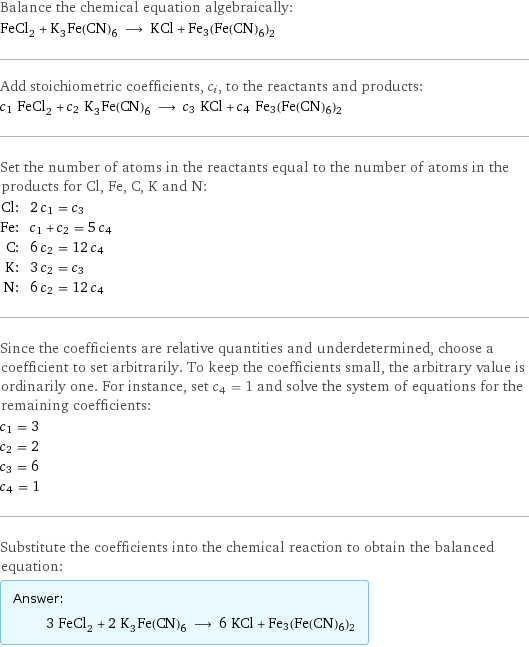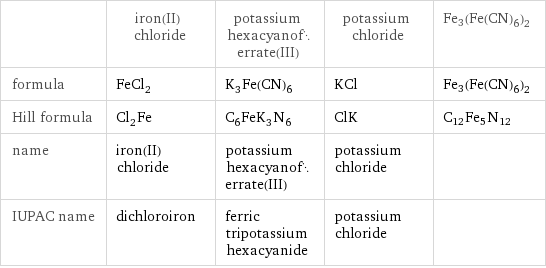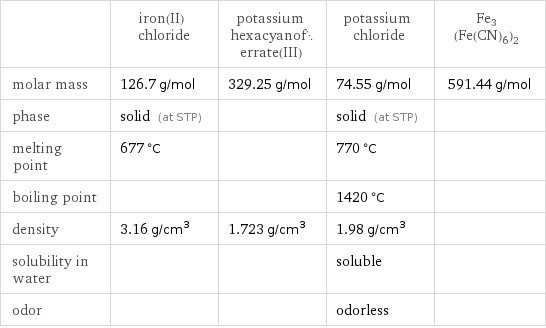Input interpretation

FeCl_2 iron(II) chloride + K_3Fe(CN)_6 potassium hexacyanoferrate(III) ⟶ KCl potassium chloride + Fe3(Fe(CN)6)2
Balanced equation

Balance the chemical equation algebraically: FeCl_2 + K_3Fe(CN)_6 ⟶ KCl + Fe3(Fe(CN)6)2 Add stoichiometric coefficients, c_i, to the reactants and products: c_1 FeCl_2 + c_2 K_3Fe(CN)_6 ⟶ c_3 KCl + c_4 Fe3(Fe(CN)6)2 Set the number of atoms in the reactants equal to the number of atoms in the products for Cl, Fe, C, K and N: Cl: | 2 c_1 = c_3 Fe: | c_1 + c_2 = 5 c_4 C: | 6 c_2 = 12 c_4 K: | 3 c_2 = c_3 N: | 6 c_2 = 12 c_4 Since the coefficients are relative quantities and underdetermined, choose a coefficient to set arbitrarily. To keep the coefficients small, the arbitrary value is ordinarily one. For instance, set c_4 = 1 and solve the system of equations for the remaining coefficients: c_1 = 3 c_2 = 2 c_3 = 6 c_4 = 1 Substitute the coefficients into the chemical reaction to obtain the balanced equation: Answer: | | 3 FeCl_2 + 2 K_3Fe(CN)_6 ⟶ 6 KCl + Fe3(Fe(CN)6)2
Structures

+ ⟶ + Fe3(Fe(CN)6)2
Names

iron(II) chloride + potassium hexacyanoferrate(III) ⟶ potassium chloride + Fe3(Fe(CN)6)2
Equilibrium constant
![Construct the equilibrium constant, K, expression for: FeCl_2 + K_3Fe(CN)_6 ⟶ KCl + Fe3(Fe(CN)6)2 Plan: • Balance the chemical equation. • Determine the stoichiometric numbers. • Assemble the activity expression for each chemical species. • Use the activity expressions to build the equilibrium constant expression. Write the balanced chemical equation: 3 FeCl_2 + 2 K_3Fe(CN)_6 ⟶ 6 KCl + Fe3(Fe(CN)6)2 Assign stoichiometric numbers, ν_i, using the stoichiometric coefficients, c_i, from the balanced chemical equation in the following manner: ν_i = -c_i for reactants and ν_i = c_i for products: chemical species | c_i | ν_i FeCl_2 | 3 | -3 K_3Fe(CN)_6 | 2 | -2 KCl | 6 | 6 Fe3(Fe(CN)6)2 | 1 | 1 Assemble the activity expressions accounting for the state of matter and ν_i: chemical species | c_i | ν_i | activity expression FeCl_2 | 3 | -3 | ([FeCl2])^(-3) K_3Fe(CN)_6 | 2 | -2 | ([K3Fe(CN)6])^(-2) KCl | 6 | 6 | ([KCl])^6 Fe3(Fe(CN)6)2 | 1 | 1 | [Fe3(Fe(CN)6)2] The equilibrium constant symbol in the concentration basis is: K_c Mulitply the activity expressions to arrive at the K_c expression: Answer: | | K_c = ([FeCl2])^(-3) ([K3Fe(CN)6])^(-2) ([KCl])^6 [Fe3(Fe(CN)6)2] = (([KCl])^6 [Fe3(Fe(CN)6)2])/(([FeCl2])^3 ([K3Fe(CN)6])^2)](../image_source/ce4dd3e3846257bf5b7b123b12163ef8.png)
Construct the equilibrium constant, K, expression for: FeCl_2 + K_3Fe(CN)_6 ⟶ KCl + Fe3(Fe(CN)6)2 Plan: • Balance the chemical equation. • Determine the stoichiometric numbers. • Assemble the activity expression for each chemical species. • Use the activity expressions to build the equilibrium constant expression. Write the balanced chemical equation: 3 FeCl_2 + 2 K_3Fe(CN)_6 ⟶ 6 KCl + Fe3(Fe(CN)6)2 Assign stoichiometric numbers, ν_i, using the stoichiometric coefficients, c_i, from the balanced chemical equation in the following manner: ν_i = -c_i for reactants and ν_i = c_i for products: chemical species | c_i | ν_i FeCl_2 | 3 | -3 K_3Fe(CN)_6 | 2 | -2 KCl | 6 | 6 Fe3(Fe(CN)6)2 | 1 | 1 Assemble the activity expressions accounting for the state of matter and ν_i: chemical species | c_i | ν_i | activity expression FeCl_2 | 3 | -3 | ([FeCl2])^(-3) K_3Fe(CN)_6 | 2 | -2 | ([K3Fe(CN)6])^(-2) KCl | 6 | 6 | ([KCl])^6 Fe3(Fe(CN)6)2 | 1 | 1 | [Fe3(Fe(CN)6)2] The equilibrium constant symbol in the concentration basis is: K_c Mulitply the activity expressions to arrive at the K_c expression: Answer: | | K_c = ([FeCl2])^(-3) ([K3Fe(CN)6])^(-2) ([KCl])^6 [Fe3(Fe(CN)6)2] = (([KCl])^6 [Fe3(Fe(CN)6)2])/(([FeCl2])^3 ([K3Fe(CN)6])^2)
Rate of reaction
![Construct the rate of reaction expression for: FeCl_2 + K_3Fe(CN)_6 ⟶ KCl + Fe3(Fe(CN)6)2 Plan: • Balance the chemical equation. • Determine the stoichiometric numbers. • Assemble the rate term for each chemical species. • Write the rate of reaction expression. Write the balanced chemical equation: 3 FeCl_2 + 2 K_3Fe(CN)_6 ⟶ 6 KCl + Fe3(Fe(CN)6)2 Assign stoichiometric numbers, ν_i, using the stoichiometric coefficients, c_i, from the balanced chemical equation in the following manner: ν_i = -c_i for reactants and ν_i = c_i for products: chemical species | c_i | ν_i FeCl_2 | 3 | -3 K_3Fe(CN)_6 | 2 | -2 KCl | 6 | 6 Fe3(Fe(CN)6)2 | 1 | 1 The rate term for each chemical species, B_i, is 1/ν_i(Δ[B_i])/(Δt) where [B_i] is the amount concentration and t is time: chemical species | c_i | ν_i | rate term FeCl_2 | 3 | -3 | -1/3 (Δ[FeCl2])/(Δt) K_3Fe(CN)_6 | 2 | -2 | -1/2 (Δ[K3Fe(CN)6])/(Δt) KCl | 6 | 6 | 1/6 (Δ[KCl])/(Δt) Fe3(Fe(CN)6)2 | 1 | 1 | (Δ[Fe3(Fe(CN)6)2])/(Δt) (for infinitesimal rate of change, replace Δ with d) Set the rate terms equal to each other to arrive at the rate expression: Answer: | | rate = -1/3 (Δ[FeCl2])/(Δt) = -1/2 (Δ[K3Fe(CN)6])/(Δt) = 1/6 (Δ[KCl])/(Δt) = (Δ[Fe3(Fe(CN)6)2])/(Δt) (assuming constant volume and no accumulation of intermediates or side products)](../image_source/b7994282f356be3b83eb1dfe3fb7b49f.png)
Construct the rate of reaction expression for: FeCl_2 + K_3Fe(CN)_6 ⟶ KCl + Fe3(Fe(CN)6)2 Plan: • Balance the chemical equation. • Determine the stoichiometric numbers. • Assemble the rate term for each chemical species. • Write the rate of reaction expression. Write the balanced chemical equation: 3 FeCl_2 + 2 K_3Fe(CN)_6 ⟶ 6 KCl + Fe3(Fe(CN)6)2 Assign stoichiometric numbers, ν_i, using the stoichiometric coefficients, c_i, from the balanced chemical equation in the following manner: ν_i = -c_i for reactants and ν_i = c_i for products: chemical species | c_i | ν_i FeCl_2 | 3 | -3 K_3Fe(CN)_6 | 2 | -2 KCl | 6 | 6 Fe3(Fe(CN)6)2 | 1 | 1 The rate term for each chemical species, B_i, is 1/ν_i(Δ[B_i])/(Δt) where [B_i] is the amount concentration and t is time: chemical species | c_i | ν_i | rate term FeCl_2 | 3 | -3 | -1/3 (Δ[FeCl2])/(Δt) K_3Fe(CN)_6 | 2 | -2 | -1/2 (Δ[K3Fe(CN)6])/(Δt) KCl | 6 | 6 | 1/6 (Δ[KCl])/(Δt) Fe3(Fe(CN)6)2 | 1 | 1 | (Δ[Fe3(Fe(CN)6)2])/(Δt) (for infinitesimal rate of change, replace Δ with d) Set the rate terms equal to each other to arrive at the rate expression: Answer: | | rate = -1/3 (Δ[FeCl2])/(Δt) = -1/2 (Δ[K3Fe(CN)6])/(Δt) = 1/6 (Δ[KCl])/(Δt) = (Δ[Fe3(Fe(CN)6)2])/(Δt) (assuming constant volume and no accumulation of intermediates or side products)
Chemical names and formulas

| iron(II) chloride | potassium hexacyanoferrate(III) | potassium chloride | Fe3(Fe(CN)6)2 formula | FeCl_2 | K_3Fe(CN)_6 | KCl | Fe3(Fe(CN)6)2 Hill formula | Cl_2Fe | C_6FeK_3N_6 | ClK | C12Fe5N12 name | iron(II) chloride | potassium hexacyanoferrate(III) | potassium chloride | IUPAC name | dichloroiron | ferric tripotassium hexacyanide | potassium chloride |
Substance properties

| iron(II) chloride | potassium hexacyanoferrate(III) | potassium chloride | Fe3(Fe(CN)6)2 molar mass | 126.7 g/mol | 329.25 g/mol | 74.55 g/mol | 591.44 g/mol phase | solid (at STP) | | solid (at STP) | melting point | 677 °C | | 770 °C | boiling point | | | 1420 °C | density | 3.16 g/cm^3 | 1.723 g/cm^3 | 1.98 g/cm^3 | solubility in water | | | soluble | odor | | | odorless |
Units
